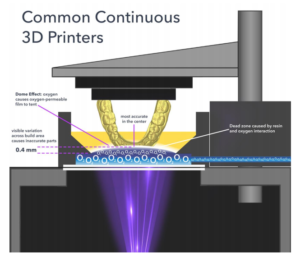
 High-speed continuous 3D printing has captured a lot of attention in recent years, and basically the method is an upgraded approach to Digital Light Processing (DLP) technology, which EnvisionTEC commercialized in 2002.
High-speed continuous 3D printing has captured a lot of attention in recent years, and basically the method is an upgraded approach to Digital Light Processing (DLP) technology, which EnvisionTEC commercialized in 2002.
With continuous printing, light can cure photosensitive polymers without being interrupted, as the build plate constantly moves in the Z direction – this results in high-speed 3D printing, without using as many supports and many other benefits.
But this method of 3D printing also comes with some serious challenges, which is the subject of a recently published white paper on the subject, “The Ultimate Guide to High-Speed 3D Printing with Continuous Technology.”
EnvisionTEC should know. The company first filed for a patent on continuous 3D printing in 2006; it was granted in 2011.
While many people know the benefits of continuous 3D printing, including speed and theoretically isotropic parts, this paper takes a deeper dive into the “dead zone” that is so critical to continuous 3D printing.
The dead zone is an area where oxygen and photopolymer commingle. Because oxygen inhibits polymerization, nothing cures in the the dead zone, which allows for 3D printing in free space right above the dead zone.
However, adding oxygen to the build area also distorts the build surface, essentially creating an air balloon at the bottom of the build tray. It’s no surprise EnvisionTEC has a patent-pending solution to this problem.
EnvisionTEC didn’t get to be a leader in the industry without having some quality 3D printers behind its name. The company boasts a variety of 3D printer models across six platforms, and works hard to make sure that all of its 3D printing solutions, from dental and orthodontics to jewelry and everything in between, are at the top of the pack.
EnvisionTEC’s new Continuous Digital Light Manufacturing (cDLM) 3D printer line comes with a new patent-pending domeless material tray that is said to deliver accuracy across the entire build area, while common continuous 3D printers only deliver high accuracy in the centermost part of the build area.
According to the white paper, “At EnvisionTEC, where continuous 3D printing has been under development for more than a decade, a patent-pending material tray was invented to correct for this dome effect and to evenly control the pressure of oxygen across the entire build tray. This ensures a flat and even dead zone and build surface for continuous 3D printing.”
The Quest for Speed in 3D Printing
We’re always looking for more speed in the 3D printing world – SLA, one of the earliest 3D printing technologies, is a fairly slow process, so when EnvisionTEC brought DLP to the market over a decade ago, the innovation, according to the white paper, “represented a significant leap in print speeds that allowed 3D printing’s first deployment in mass customized production.”
But, while it was much faster to use an HD projector to expose an entire layer of resin at a time, users still had to pause in between each exposure to peel and reposition the build platform. So the thought of continuous DLP printing in the Z axis, without having to wait after each layer, is an exciting one.

SLA (left) slowly draws a part in resin with a laser beam. DLP (right) works faster because it doesn’t have to draw every single line and can cure an entire layer in one exposure.
Benefits of continuous 3D printing include:
- Theoretically allowing for isotropic properties by printing continuously in the Z axis
- High-speed 3D printing lets users process chemistries that were previously not possible
- Continuously printed parts are consistent, with a smooth surface finish and no clear weak points between layers
 To learn more about continuous 3D printing, you can download EnvisionTEC’s white paper here for free.
To learn more about continuous 3D printing, you can download EnvisionTEC’s white paper here for free.
Discuss this and other 3D printing topics at 3DPrintBoard.com or share your thoughts below.
[Images: EnvisionTEC]
Subscribe to Our Email Newsletter
Stay up-to-date on all the latest news from the 3D printing industry and receive information and offers from third party vendors.
You May Also Like
3D Printing Unpeeled: New Arkema Material for HP, Saddle and Macro MEMS
A new Arkema material for MJF is said to reduce costs per part by up to 25% and have an 85% reusability ratio. HP 3D HR PA 12 S has been...
3D Printing News Briefs, January 20, 2024: FDM, LPBF, Underwater 3D Printer, Racing, & More
We’re starting off with a process certification in today’s 3D Printing News Briefs, and then moving on to research about solute trapping, laser powder bed fusion, and then moving on...
3D Printing Webinar and Event Roundup: December 3, 2023
We’ve got plenty of events and webinars coming up for you this week! Quickparts is having a Manufacturing Roadshow, America Makes is holding a Member Town Hall, Stratafest makes two...
Formnext 2023 Day Three: Slam Dunk
I’m high—high on trade show. I’ve met numerous new faces and reconnected with old friends, creating an absolutely wonderful atmosphere. The excitement is palpable over several emerging developments. The high...


































